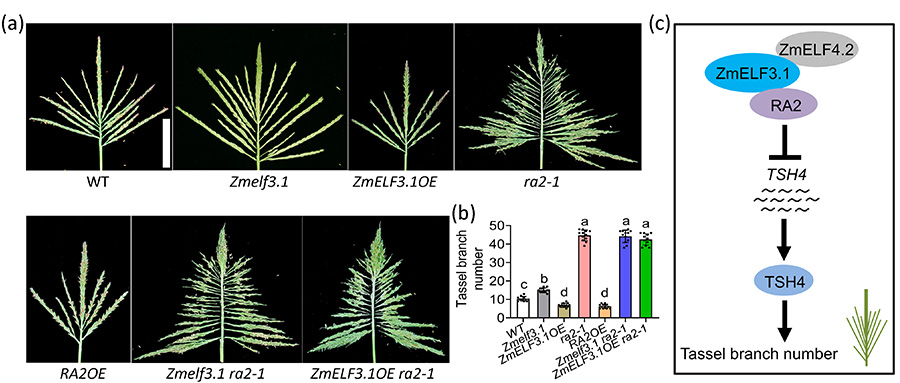Recently, the Institute of Biotechnology, Chinese Academy of Agricultural Sciences (BRI-CAAS), in collaboration with South China Agricultural University (SCAU), revealed the molecular mechanism of the photoperiod response factor ZmELF3.1 regulating the tassel branch number in maize. The work was published in the internationally renowned journal "New Phytologist" on October 19th with the title of "ZmELF3.1 integrates the RA2-TSH4 module to repress maize tassel branching".
Inflorescence size is an important agronomic trait of crops, which not only affects the success of plant reproduction, but also determines crop yield. Corn is a hermaphroditic crop with male inflorescences (tassels) located at the top of the plant. The number of tassel branches, total tassel length, andtasselbranch angle have complex relationships with maize yield, and are important target traits for maize genetic breeding. However, the molecular regulatory mechanism of tassel branch number (TBN) in maize is still unclear. Thisstudyshowed that loss-of-function of ZmELF3.1 results in increasednumber of tassel branches in maize and RA2 directly binds to the promoter of TSH4 and represses its expression whichleading to the decrease in tassel branch number. Thisstudy also showed that ZmELF3.1 (and its homologue ZmELF3.2) directly interacts with both RA2 and ZmELF4.2 to form tri-protein complexes, which promotes the binding of RA2 to the promoter of TSH4 and enhance the inhibitory effects of RA2 on TSH4 expression, consequently decreasing tassel branching.

Professor Yurong Xie and Dr.Yongping Zhao from BRI-CAAS are the co-first authors for this work and Professor Haiyang Wang from SCAU is the corresponding author. This work was supported by National Key R&D Program of China (grant nos. 2020YFE0202300, 2021YFF1000300 and 2022YFF1001702) and the Agricultural Science and Technology Innovation Program of Chinese Academy of Agricultural Sciences, and a project from Hainan Yazhou Bay Seed Lab (B21HJ8101).
For details, please visit athttps://nph.onlinelibrary.wiley.com/doi/10.1111/nph.19329 |